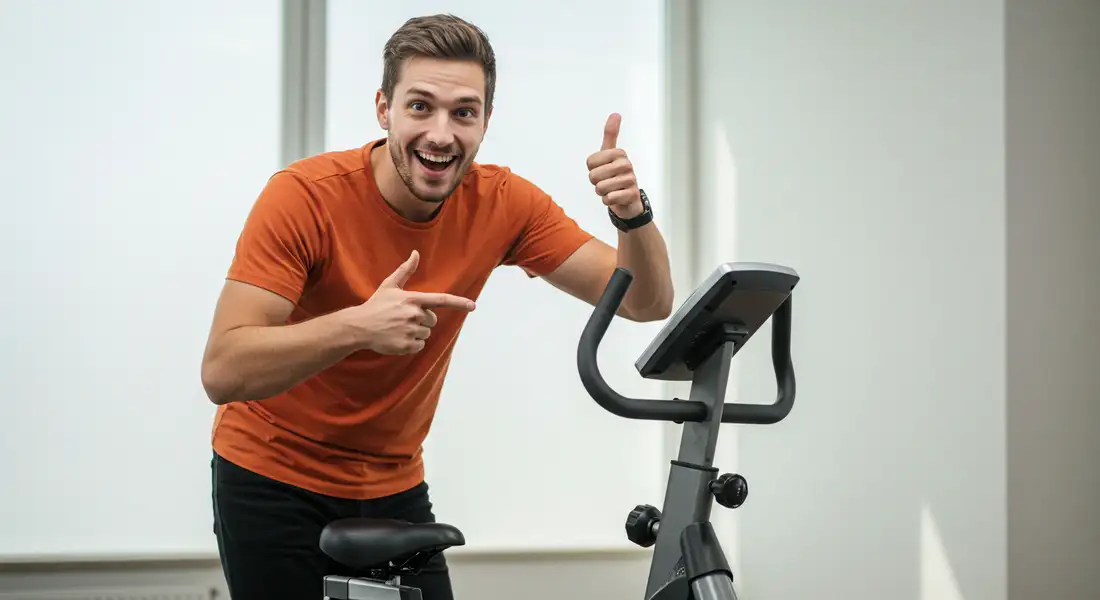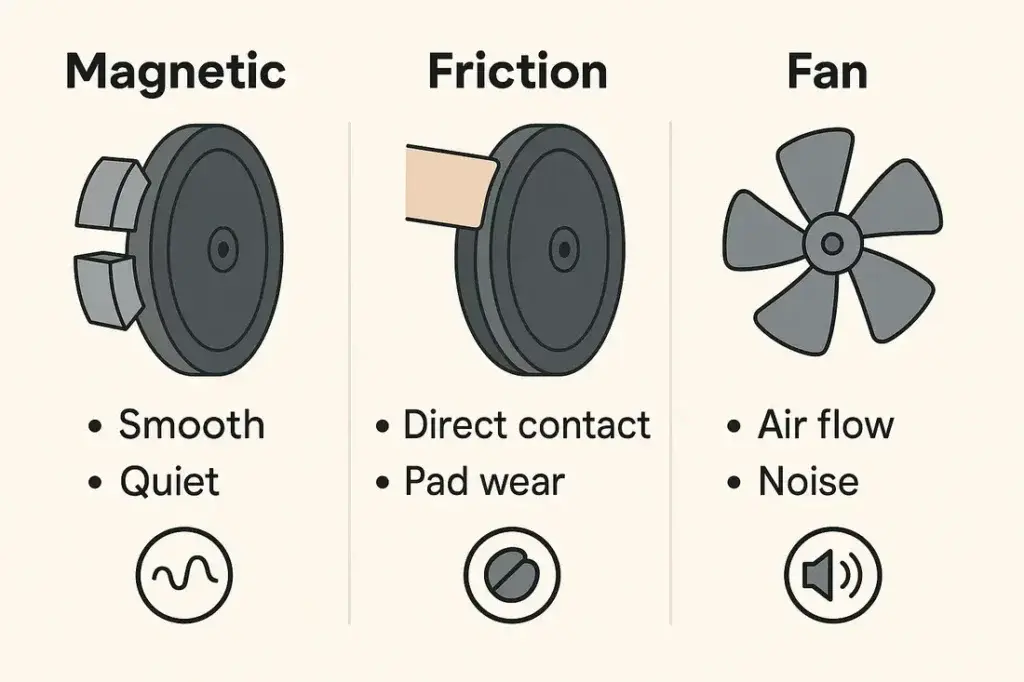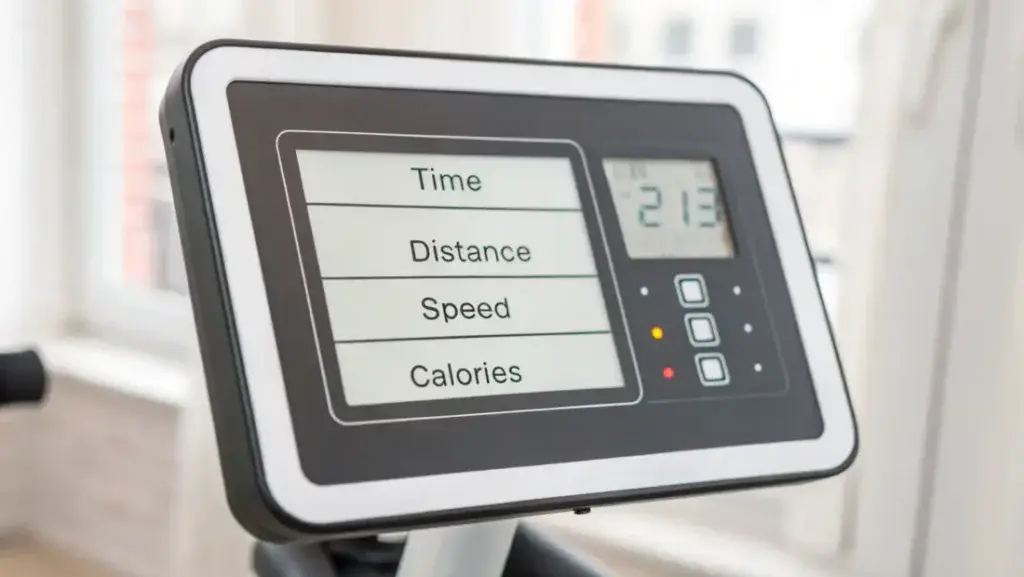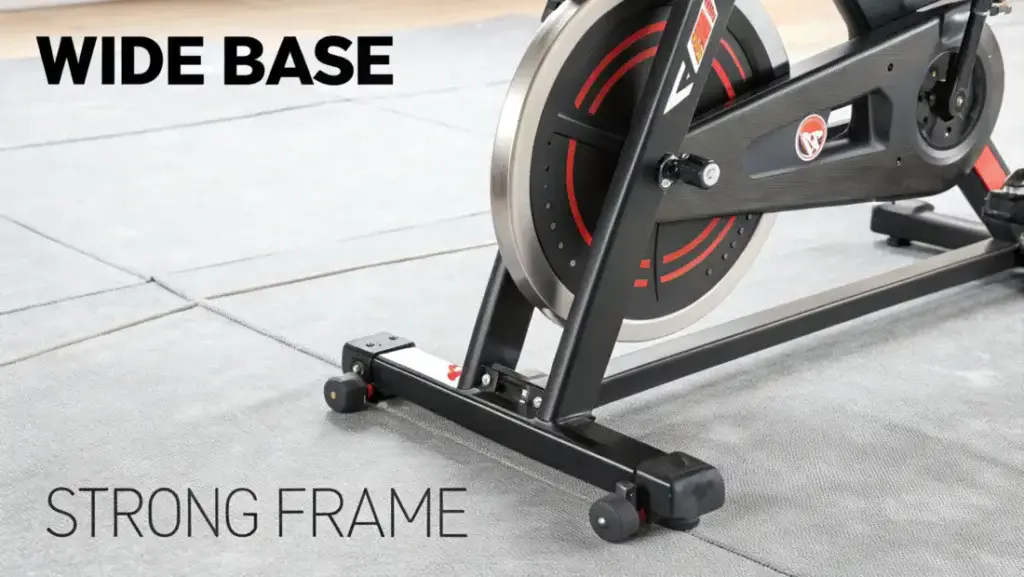You’re geared up and ready to bring home your first exercise bike – brilliant! Maybe you’ve already navigated the Upright vs. Recumbent vs. Spin Bikes dilemma or are buzzing from learning about the benefits of home cycling.
But now you’re staring at spec sheets that look like a different language. “Magnetic vs. Friction Resistance?” “Flywheel Weight?” “Multi-Grip Handlebars?”

It’s enough to make anyone’s head spin!
Fear not, future fitness fanatic! This guide is your no-nonsense decoder ring.
We’re cutting through the marketing fluff to pinpoint the beginner exercise bike features that genuinely matter for a comfortable, effective, and motivating start.
Because the best exercise bike for beginners isn’t necessarily the one with the longest feature list; it’s the one that gets the fundamentals perfectly right for you.
Key Takeaways: Your Non-Negotiable Feature Checklist
- Smooth, Adjustable Resistance: This is the heart of your workout. Aim for quality over quantity of levels initially.
- Critical Adjustability (Seat & Handlebars): Essential for comfort, safety, and making the bike feel like it was made for you.
- Clear, Basic Monitor: Track your progress simply with time, distance, speed, and estimated calories.
- Rock-Solid Stability & Build: A secure bike inspires confident pedaling.
- Smart Comfort Touches (Saddle, Pedals): These “small” things can make a huge difference in your desire to ride.
The “Engine” of Your Workout – Understanding Resistance Systems for Beginners
Think of the resistance system as the engine of your exercise bike – it’s what provides the challenge and allows you to progress.
For a beginner, getting this right is crucial for both effectiveness and enjoyment.
A. Why Resistance Matters More Than You Think (Especially for Newbies)
It’s easy to assume that as a beginner, you’ll just be pedaling lightly. But even from day one, having adjustable resistance is key:
- It’s How You Progress: You need to be able to make your workouts slightly harder over time to keep improving your fitness. This is the principle of progressive overload.
- Workout Tailoring: Feeling energetic? Dial it up. Need an easier day? Dial it down. Resistance gives you control.
- Prevents Early Plateaus: If the bike is always “too easy,” you’ll quickly stop seeing results and lose motivation.
B. Decoding Resistance Types – The Beginner’s Cheat Sheet

You’ll mainly encounter three types. For most beginners, one stands out:
- Magnetic Resistance (Often the Beginner’s Best Friend):
- How it works (simply): Powerful magnets are moved closer to or further from the metal flywheel as you adjust the resistance knob or buttons. There’s no physical contact, hence no friction.
- Why it rocks for beginners:
- Smooth & Consistent: The feeling is very fluid and predictable.
- Quiet Operation: Perfect for home environments where noise can be an issue (think sleeping family members or thin walls!).
- Low Maintenance: No pads to wear out or replace.
- Wide Range of Levels: Even basic magnetic systems offer enough variation for beginners.
- What to look for: Don’t fixate on a massive number of levels. 8-16 distinct, noticeable levels are often more than enough for a beginner to progress effectively.
- Friction Resistance (Common on Spin Bikes, Less So for Beginner Uprights/Recumbents):
- How it works: A pad, usually made of felt or leather, physically presses against the flywheel to create resistance, much like brakes on an outdoor bike.
- Pros: Can offer incredibly high levels of resistance, and some prefer the “direct” feel.
- Cons for beginners:
- Can sometimes feel less smooth or consistent than magnetic.
- The pads wear out over time and need replacement.
- Adjustment might be less precise (e.g., a turn-knob with infinite adjustment rather than distinct levels).
- Fan/Air Resistance (Less Common for Typical Beginner Bikes):
- How it works: Pedaling spins a large fan. The harder and faster you pedal, the more air resistance the fan blades encounter.
- Pros: The resistance naturally scales with your effort – theoretically “infinite.”
- Cons for beginners:
- NOISY! These can sound like a small wind tunnel.
- The resistance might not feel as controlled for very gentle start-ups or specific intensity targets.
My advice for most beginners looking at upright or recumbent bikes? Prioritize a good magnetic resistance system. It’s generally the most user-friendly and hassle-free.
C. Flywheel Weight – Does Heavier Always Mean Better for Beginners?
You’ll see flywheel weight listed in specs (e.g., 15 lbs, 20 lbs, etc.).
A heavier flywheel can contribute to a smoother pedaling sensation, particularly on spin bikes where momentum is key.
However, for beginner-focused upright and recumbent bikes with good magnetic resistance, the quality of that magnetic system often has a greater impact on smoothness than an extra-heavy flywheel.
Don’t get overly fixated on this number if the bike otherwise ticks your boxes.
Your Perfect Fit Formula – Why Adjustability is Non-Negotiable

Imagine trying to run a marathon in shoes two sizes too small.
That’s what riding a poorly adjusted exercise bike feels like – uncomfortable, inefficient, and a recipe for quitting.
Adjustability isn’t a luxury; it’s fundamental.
A. This Isn’t Just About Comfort – It’s About Safety & Effectiveness
A bike that doesn’t fit you properly can lead to:
- Knee pain (from incorrect seat height)
- Lower back strain
- Wrist or shoulder discomfort
- Reduced power output (meaning a less effective workout)
- An increased risk of injury
Conversely, a bike that’s perfectly dialed into your body dimensions will feel like an extension of yourself, making your workouts more enjoyable and productive.
For a detailed guide on getting it just right, check out our Exercise Bike Setup Guide.
B. The “Must-Have” Adjustment Points for Beginners
Focus on these key areas:
- Seat Height:
- Why it’s critical: Ensures proper leg extension. Too low, and your knees will be overly bent, leading to inefficiency and potential pain. Too high, and you’ll be overreaching, which can strain hamstrings and cause hip rocking.
- What to look for: An easy-to-use adjustment mechanism (a pop-pin knob or lever is common) and a range that comfortably accommodates your inseam length.
- Seat Fore/Aft (Horizontal Position):
- Why it’s critical: This allows you to position your knee correctly over the pedal spindle, which is crucial for efficient power transfer and protecting your knees.
- What to look for: A smooth sliding mechanism that locks securely in place.
- Handlebar Adjustability (Height, and Sometimes Reach/Angle):
- Why it’s important: Particularly on upright and spin bikes, handlebar position significantly impacts your upper body comfort, posture, and any strain on your wrists, shoulders, and back. Beginners often prefer a more upright, less aggressive handlebar position.
- What to look for: A good range of height adjustment. Reach (fore/aft) adjustment is a bonus, especially on spin bikes.
C. Quick Tip – Check the “User Height Range” Specification
Most manufacturers will list a recommended user height range for their bikes.
While not always perfectly accurate for every body proportion, it’s a good initial indicator of whether the bike’s adjustment capabilities will suit you.
Tracking Your Triumphs – The Exercise Bike Monitor (Console) De-Mystified
The console, or monitor, is your window into your workout.
For beginners, it doesn’t need to be a supercomputer, but it does need to provide clear, essential feedback.
A. Why Even Basic Tracking Matters for Beginner Motivation
Seeing your numbers – how long you’ve pedaled, how “far” you’ve gone – provides instant positive reinforcement.
It turns an abstract effort into tangible data, which is incredibly motivating and helps you see progress over time.
As studies from the National Institutes of Health suggest, self-monitoring is a key component of successful behavior change.
B. Essential Metrics Your Beginner Console Must Have

Forget flashy graphics for a moment. These are the core data points:
- Time: The duration of your current workout session.
- Distance: A virtual measure of how far you’ve “cycled.”
- Speed: Your current pedaling pace, often shown in MPH or KPH.
- Calories Burned (Estimated): While this is always an estimate (as true calorie burn depends on many individual factors), it’s a popular and motivating metric for many beginners.
C. “Nice-to-Have” vs. “Need-to-Have” Console Features for Beginners
- Heart Rate Monitoring (Grips vs. Chest Strap Compatibility):
- Grip Sensors: Built into the handlebars. Convenient for a quick check, but their accuracy can be variable. Fine for a general idea of your effort level.
- Chest Strap Compatibility: The bike’s console can receive data from a separate chest strap monitor (usually sold separately). This is far more accurate if you plan to train in specific heart rate zones. For most beginners, grip sensors are adequate to start.
- Pre-set Workout Programs: These can add variety and structure (e.g., “hills,” “intervals”). Nice, but not essential if you’re comfortable guiding your own workouts initially.
- RPM (Revolutions Per Minute): This measures your pedaling cadence. It’s more commonly found and utilized on spin bikes, where maintaining a specific RPM is often part of the workout.
- Bluetooth/App Connectivity: Allows the bike to sync with fitness apps for more detailed tracking, virtual rides, or guided classes. This is a fantastic feature but often adds to the cost. Beginner advice: Master the basics on a simpler console first. You can often use fitness apps on your own phone or tablet alongside any bike.
D. The Golden Rule for Beginner Consoles: Clarity & Ease of Use > Fancy Features
Look for a display that is large, well-lit, and easy to read at a glance, even when you’re pedaling.
The buttons should be intuitive and simple to operate. A confusing console is a frustrating console.
Building on a Solid Foundation – Stability, Build Quality & Weight Capacity
No matter how great the other features are, if your bike feels like it’s going to topple over or creaks ominously with every pedal stroke, your workout experience will suffer.
A. Why a Wobbly Bike is a Workout Killer (and a Confidence Crusher)
You need to feel safe and secure on your bike, especially as you start to increase your speed or resistance.
A wobbly or unstable bike is distracting, unnerving, and can even be dangerous.
B. What to Look For (Even on a Budget)

- Maximum User Weight Capacity: This is a crucial indicator of a bike’s overall build quality and stability. Always choose a bike with a maximum user weight rating that is significantly higher than your actual weight. This provides a good margin for stability and durability. Reputable sources like Consumer Reports often highlight this as a key factor in their buying guides.
- Bike Weight & Base Design: Generally, a heavier bike with a wider base (the footprint on the floor) will be more stable.
- Levelers: These are adjustable feet, usually on the front and/or rear stabilizers, that allow you to compensate for slightly uneven floors and ensure the bike sits flat and doesn’t rock.
The “Little Things” That Make a Big Difference – Comfort & Convenience Features
These might seem like minor details, but they can significantly impact your overall comfort and your willingness to use the bike regularly.
A. Saddle (Seat) Comfort – Your Derriere Will Thank You!
This is a big one, especially for upright bikes. Beginner sensibilité often clashes with narrow, firm saddles.
- What to look for: For upright bikes, look for saddles that are a bit wider and have more cushioning. Recumbent bikes inherently have large, comfortable seats.
- Beginner Lifesaver: Remember, you can often replace the saddle on most bikes if the stock one isn’t cutting it, or simply add a gel seat cover for extra cushioning.
B. Pedal Design- Keeping Your Feet Happy & Secure
Your feet are your connection to the bike, so pedal comfort and security matter.
- What to look for: Pedals that are wide enough to comfortably support your feet and have adjustable straps to keep your feet from slipping, especially during more vigorous pedaling. A textured surface for better grip is also a plus.
C. “Bonus” Conveniences (Consider if Your Budget Allows)
These aren’t strictly essential, but they enhance the experience:
- Water Bottle Holder: Crucial for staying hydrated during your workout. Surprisingly, not all basic bikes include one!
- Device Holder (Tablet/Phone): If you plan to watch videos, listen to music, or use fitness apps on your own device, a built-in holder is incredibly convenient.
- Transport Wheels: Small wheels, usually on the front stabilizer, make it much easier to move the bike for storage or cleaning if needed.
Feature Overload vs. Beginner Essentials – A Quick Recap Table
To help you prioritize, here’s a quick summary:
| Feature Category | Must-Have for Beginners | Nice-to-Have (Consider if budget allows) | Potentially Overkill (Initially) |
| Resistance | Smooth, Adjustable (Magnetic often best) | Many distinct levels (e.g., 16+) | App-controlled smart resistance |
| Adjustability | Seat Height, Seat Fore/Aft, Handlebar (Upright/Spin) | Quick-release levers for easy changes | Micro-adjustments beyond basic needs |
| Monitor/Console | Time, Distance, Speed, Calories (Clear, Easy-to-Read Display) | Heart Rate Grip Sensors, Basic Pre-set Programs, RPM (Spin) | Large HD Touchscreens, Full App Suite |
| Stability/Build | High Max User Weight Capacity, Sturdy Frame, Levelers | Heavier overall bike weight for added stability | Commercial-grade construction |
| Comfort/Convenience | Comfortable Saddle (appropriate for bike type), Secure Pedals with Straps, Water Bottle Holder | Device Holder, Transport Wheels | Advanced ergonomic contouring |
Frequently Asked Questions (FAQs) About Beginner Exercise Bike Features
- Q1: Do I really need a bike with tons of resistance levels as a beginner?
- A: Not necessarily. For a beginner, having 8-12 clearly distinct and noticeable levels of resistance on a magnetic system is often more than sufficient for progressive training. The quality of the resistance (smoothness, consistency) and having a good range from very easy to challenging for you is more important than just a high number of levels.
- Q2: Is a built-in heart rate monitor an essential feature for a beginner bike?
- A: It’s not strictly essential, but it can be a useful motivational tool. Handlebar grip sensors, common on many beginner bikes, provide a rough estimate. If you decide to get serious about training in specific heart rate zones later on, investing in a more accurate chest strap monitor (and ensuring your bike or a separate app can receive its signal) would be a better bet.
- Q3: Should I prioritize paying extra for Bluetooth or app connectivity on my very first bike?
- A: If your budget is a primary concern, focus your funds on the core mechanical features first: a good resistance system, comprehensive adjustability, and solid stability. App connectivity is fantastic for motivation and accessing a world of guided workouts, but you can often achieve a similar experience by using fitness apps on your own phone or tablet placed on a device holder, even with a more basic bike.
- Q4: For a beginner, what’s more critical: a very heavy flywheel or a good magnetic resistance system?
- A: For most beginner-focused upright and recumbent bikes, a well-implemented magnetic resistance system will generally contribute more to a smooth, quiet, and enjoyable pedaling experience than an ultra-heavy flywheel. For spin bikes, which aim to mimic the momentum of an outdoor road bike, flywheel weight plays a more significant role in achieving that specific feel.
Conclusion – Focus on Fundamentals for a Feature-Perfect First Ride
Navigating the world of exercise bike features doesn’t have to be a workout in itself!
By prioritizing smooth and adjustable resistance, comprehensive adjustability for a perfect fit, a clear and simple monitor for tracking basics, and solid stability, you’re setting yourself up for success.
These are the beginner exercise bike features that form the foundation of a positive and effective home cycling experience.
Don’t let yourself get “spun” by endless lists of bells and whistles.
Focus on these fundamentals, and you’ll choose a bike that not only meets your needs today but also supports your fitness journey as you grow stronger and more confident.
The best exercise bike for beginners is one that makes you want to come back for more, ride after ride.
What features are you prioritizing in your search? Or is there a feature you’re still unsure about? Let us know in the comments below!
Ready to put this knowledge into action?
- Match these essential features with your ideal bike type: Revisit our Upright vs. Recumbent vs. Spin Bikes guide.
- See how these features come together in top models: Check out our Top Recommended Exercise Bikes for Beginners.
- Got your bike? Learn how to adjust these features perfectly with our Exercise Bike Setup Guide.
Happy (and smart) shopping!
